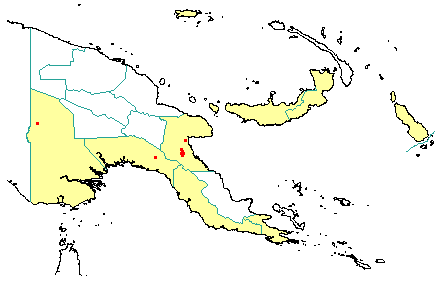
in PNGplants database
PNGTreesKey – Aglaia rimosa (Blanco) Merr. |
Barry Conn (NSW) & Kipiro Damas (LAE).
Guide to trees of Papua New Guinea
Copyright held by the authors, National Herbarium of New South Wales, and Papua New Guinea National Herbarium
Sp. Blanco. 212 (1918)
Other Literature: C.M. Pannell, Flora Malesiana, Series 1 246-248 (1995)
Family: Meliaceae
Dicotyledon
Timber Group: Non-timber species
Field Characters: Large canopy tree (up to 30 m high) or Small sub-canopy tree (10-15 m high); Bole cylindrical (up to 100 cm diam.); straight (up to 15 m long); buttresses buttresses present (buttresses up to 1 m high); spines spines absent; aerial roots aerial roots absent; stilt roots stilt roots absent; Bark brownish grey or pale brown, rough, scaly or flaky or pustular, lenticels elongated vertically; Subrhytidome (under-bark) brown; less than 25 mm thick, 10.0 (c.); bark blaze consisting of one layer; strongly aromatic; pleasant; outer blaze orange, red, or brown, slightly with stripes, slightly fibrous or granular without splinters; inner blaze orange, red, or brown, slightly with stripes, slightly fibrous or granular without splinters; bark exudate (sap) present, white/milky, not readily flowing (spotty), colour not changing on exposure to air, slightly sticky; terminal buds not enclosed by leaves.
Indumentum: Complex hairs present, disk-shaped (peltate) (on branchlets, leaves, flowers and fruits); stinging hairs absent; mature twig indumentum (hairs) present, hairs dense to sparse.
Leaves: Leaves spaced along branches, spiral (leaves occurring singly at a node and arranged spirally up the branchlet), compound (a leaf made up from two or more leaflets); petiole present, not winged, attached to base of leaf blade, at base swollen; leaves pinnate (unbranched with more than three leaflets); petiolule not swollen; rachis present, absent, absent; leaves with a terminal leaflet (the number of leaflets odd - imparipinnate), equally broad throughout much of length, 5.5-23.0 cm, 1.5-10.0 cm, leaflets alternate, slightly asymmetric, terminal developing leaflet buds straight; venation pinnate, secondary veins open, prominent, intramarginal veins absent; leaves lower surface green or greenish red, upper surface dull green, indumentum (hairs) present, indumentum (hairs) dense or sparse (peltate scales); absent; domatia absent; stipules absent.
Flowers: Inflorescence axillary, flowers on a branched axis, cones absent; flowers unisexual, unisexual with male and female flowers on different plants, stalked, flowers with many planes of symmetry, (1.1-) 1.5-2.2 (-2.5) mm long, diameter small (up to10 mm diam.) (up to c. 2 mm diam.); perianth present, with distinct sepals and petals whorls, inner perianth white, pale yellow, or cream-coloured; 4-5, free or some or partly joined; stamens 5 (male flowers) (-6), present, joined (to form a staminal tube), free of the perianth; ovary superior (female flowers), carpels joined (when more than one), locules 2; styles absent.
Fruits: Infrutescence arranged on branched axis, fruit 10.0-(c.)-15.0 mm long, yellow or dull orange, not spiny (densely covered with peltate scales), non-fleshy, simple, indehiscent or slightly dehiscent; seeds 1-(0 or 1 seed per locule)-2, about 10 mm long, not winged, broad (as wide as long), seed 1-10 mm diam. (c. 10 mm diam.).
Distribution: Morobe, Western, Gulf, Central, Milne Bay, New Britain, Manus & Bougainville.
 | Botanical records in PNGplants database |
Notes: Notes Previously known as Aglaia goebeliana Warb.